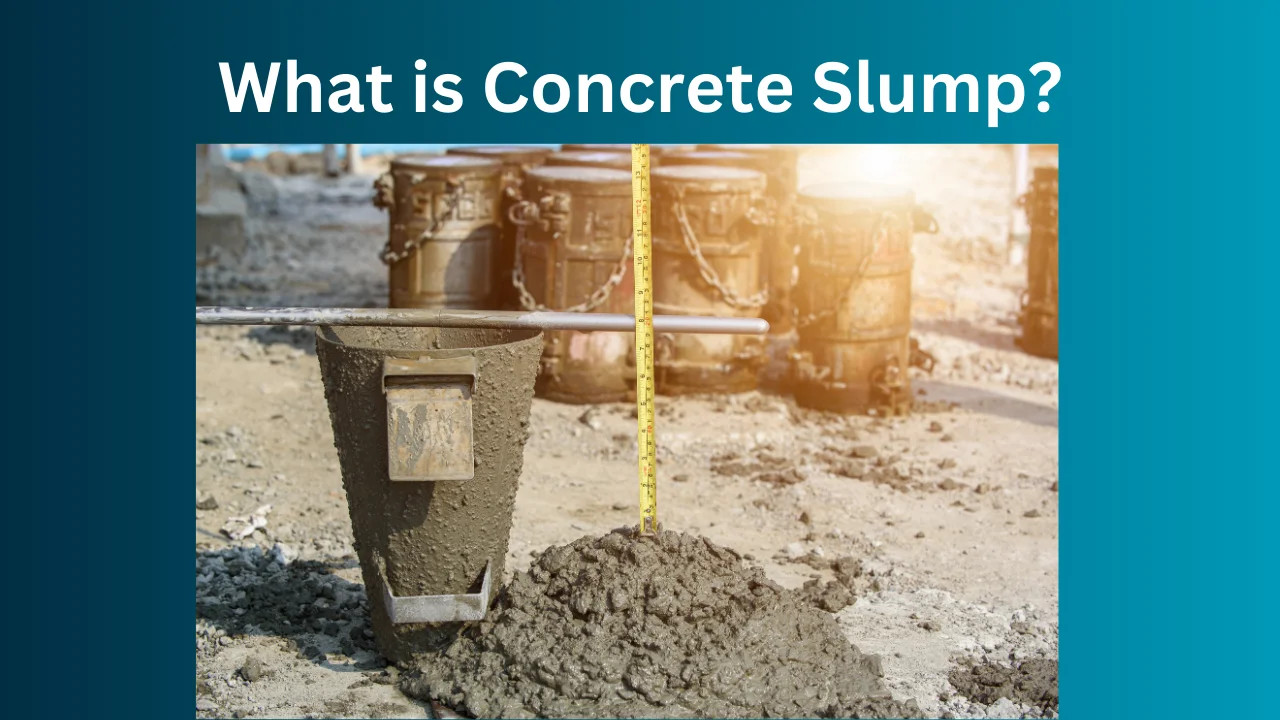Introduction
Concrete is an essential building material that supports innumerable buildings across the globe. Knowing how the consistency and workability of concrete affect your work is essential. What is concrete slump? Concrete slump comes into play in this context. If you want to know how easy it is to mix, transport, and place fresh concrete, you need to know its concrete slump, which is a measure of its consistency and workability before it sets. The article explores the significance of concrete slump, its measurement, and its effects on building projects.
Understanding Concrete Slump
Slump, a measure of how easily concrete can be worked with, is an important metric in the building sector. A cone-shaped mold is filled with new concrete for the concrete slump test, which is also called the slump cone test. The mold is then lifted to measure the amount of concrete that settles, or “slumps.” Slump is the height disparity between the concrete’s initial pour and its final, settled state. A very fluid mix would have a high value, while a value of zero would indicate extremely stiff concrete with no slump at all.
The Importance of Concrete Slump in Construction
Slump is more than just a number; it’s an important determinant of concrete’s quality and structural integrity. The ideal slump of concrete is that sweet spot between wet and dry, where the former prevents segregation and the latter makes it hard to work with and compacts poorly. The amount of water in the mixture, the size of the aggregates, and any additives used all have an impact on the slump. The concrete’s workability can be controlled to meet specific construction requirements by adjusting these factors.
Factors Affecting Concrete Slump
You can achieve the desired workability by adjusting each of the several factors that influence the slump of concrete. In order to make high-quality concrete that fits particular building requirements, it is essential to understand these factors.
Water Content
A major component influencing concrete slump is water content. When there is more water in the mixture, the slump increases, which makes the concrete easier to work with because it is more fluid. Yet, if the water content is excessive, the concrete’s strength and longevity will be diminished. For the concrete to reach the desired slump and maintain its strength and durability over time, it is crucial to maintain an appropriate water content balance.
Aggregate Size and Shape
Another factor that affects the slump is the aggregates’ size and shape when mixing concrete. Slump can be increased with smaller, rounder aggregates, and decreased with larger ones. To achieve the ideal combination of workability and strength in the concrete, the aggregates should be selected according to the project’s unique specifications.
Use of Admixtures
To change the concrete’s characteristics, admixtures are substances that are added to the mixture. They have the potential to greatly impact the slump, elevating or lowering it based on their makeup and function. As an example, admixtures such as plasticizers and superplasticizers can improve the workability and maintain the strength of concrete by increasing the slump without adding more water.
Mixing Time and Method
Another factor that can affect the slump is the way and duration of the concrete mixing process. A uniform consistency is achieved when all ingredients are mixed properly. An uneven slump, caused by either over- or under-mixing, can degrade the concrete’s overall quality.
Temperature and Environmental Conditions
Temperature is one of the environmental factors that can influence the slump of concrete. When the temperature is high, the water in the mixture evaporates rapidly, which decreases the slump. The opposite is true for cold weather, which can harden the concrete and make it more difficult to work with. To mitigate these effects, you can tweak the mixture and use the right curing techniques.
Concrete Slump Test Procedure
A simple but reliable way to determine whether concrete is workable is to run it through the concrete slump test. The test’s usefulness and ease of administration have led to its widespread use in the field.
Preparation
Make sure there is no residual concrete on any of the equipment before running the slump test. Slump cones, the mold in question, need to be damp but not soaked. The concrete mix that is being tested should be new and an accurate representation of the batch in question.
Filling the Slump Cone
Position the slump cone on a level, non-absorbent surface. The cone is then layered three times with the concrete mixture and tamped 25 times per layer to make sure it’s compacted properly. If you want an accurate slump measurement, you must do this step to remove any air pockets.
Removing the Slump Cone
After filling and leveling the cone, it is lifted vertically without twisting or lateral movement. Slumping occurs when concrete sets, and the height difference between the two is recorded. You can find the slump value using this measurement.
Interpreting the Results
You can learn a lot about the concrete’s workability from the slump value. Stiff mixes with low slumps are ideal for uses where the concrete must retain its form, like in tall buildings. For horizontal uses requiring easy spreading, a mix with a high slump is preferable because it indicates a more fluid consistency.
Common Slump Values and Their Applications
The precise requirements of the building at hand dictate the slump value that is necessary for a given construction project. If you know these numbers, you can choose the perfect concrete mix for any job.
Low Slump (0-25 mm)
Most pavements, footings, and foundations are built with a low slump. Because of this rigid mixture, the concrete will not slump or crack and will provide adequate structural support.
Medium Slump (25-75 mm)
Beams, slabs, and columns are just a few of the many uses for medium slump concrete. Because it is both strong and easy to work with, it is a versatile building material.
High Slump (75-150 mm)
Complexly shaped walls and columns, which necessitate a high degree of fluidity, are perfect candidates for high slump concrete. Thanks to its enhanced workability, placing and compacting the concrete becomes a breeze, guaranteeing a flawless finish.
Very High Slump (150 mm and above)
The self-leveling and easy-flowing properties of very high slump concrete make it a popular choice for underwater constructions and large pours. But be careful not to let segregation happen and make sure there’s enough strength.
Significance of Concrete Slump in Construction
Slump is an important measure for concrete quality and structural integrity. It aids construction industry experts in making educated decisions by providing crucial details regarding the mix’s workability.
Ensuring Structural Integrity
Maintaining the mix’s strength and durability is dependent on the slump, which is the proportion of water to other ingredients in the concrete. In order to keep buildings and other structures together, this is essential.
Improving the Surface to Your Preference
The concrete’s surface finish is influenced by the slump value. If the slump is just right, the mixture will fill the molds evenly and produce a flawless finish.
Facilitating Proper Compaction
To eliminate air pockets and guarantee a solid, dense concrete structure, proper compaction is paramount. If the slump value is correct, the concrete will be workable and compacted well.
Adapting to Construction Requirements
The necessary workability of concrete varies across different types of construction projects. For optimal concrete performance in its designated use, it is important to adjust the mix according to the results of the slump test.
Frequently Asked Questions
How to Perform a Concrete Slump Test?
The concrete slump test involves filling a cone-shaped mold with fresh concrete, lifting the mold, and measuring the height difference between the mold and the settled concrete. This value indicates the slump and provides insights into the concrete’s workability.
What Does a Low Concrete Slump Indicate?
A low concrete slump indicates a stiff mix with low workability. This is suitable for applications requiring the concrete to maintain its shape, such as in pavements and foundations.
What Are the Ideal Concrete Slump Values for Different Types of Construction?
Different construction projects require different slump values. Low slump (0-25 mm) is used for pavements, medium slump (25-75 mm) for beams and slabs, high slump (75-150 mm) for walls and columns, and very high slump (150 mm and above) for self-leveling applications.
How Does Water Content Affect Concrete Slump?
Water content is a primary factor affecting concrete slump. More water leads to a higher slump, making the concrete more fluid and workable. However, too much water can weaken the concrete and reduce its durability.
What is the Significance of Concrete Slump in Construction?
Concrete slump is crucial for ensuring the quality and integrity of concrete structures. It provides valuable information about the mix’s workability, helping construction professionals make informed decisions to achieve the desired structural performance.
Conclusion
The slump of freshly mixed concrete is a crucial indicator of its workability and consistency. What is Concrete Slump? In order to guarantee the quality, strength, and longevity of concrete structures, it is essential to comprehend and manage the slump value. Professionals in the construction industry can accomplish their goals and create long-lasting structures by performing slump tests and making necessary adjustments to the mix. The construction industry relies on this essential quality control measure to guarantee that each batch of concrete is tailored to the exact specifications of each project.

Shannon Reyes is a seasoned writer with a knack for crafting engaging blogs on a variety of service industries, including plumbing, cleansing, moving, pest control, and roofing. With a keen eye for detail and a passion for helping readers navigate complex topics, Shannon brings her expertise to life through informative and accessible content.










